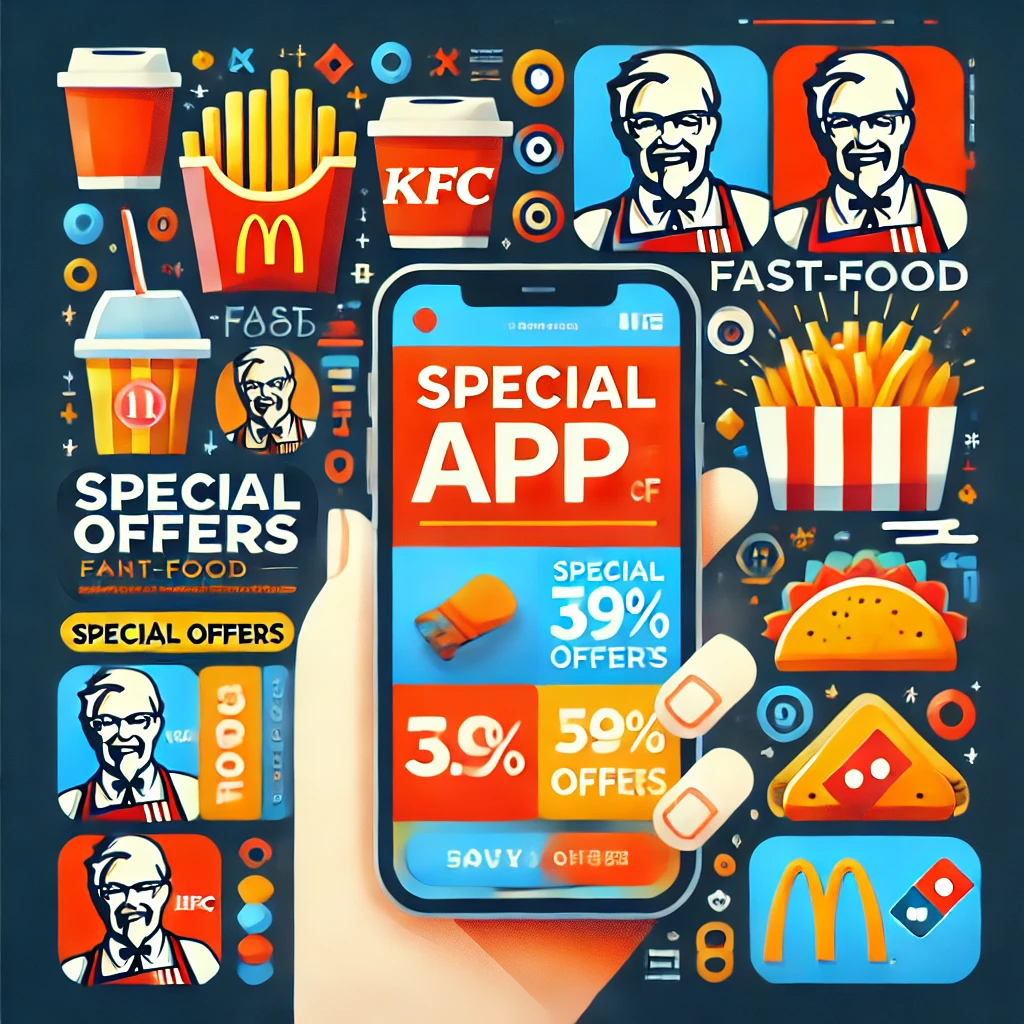The fast-food industry is currently experiencing a surge in promotional offers as companies compete to attract customers in a challenging economic environment. Major chains such as McDonald’s, KFC, and Domino’s are introducing various deals, including low-priced breakfasts and lunch specials, to entice consumers who are becoming increasingly budget-conscious. According to data from Meaningful Vision, the number of promotions in fast-food restaurants and bakeries rose by one-third from April to June compared to the previous year. This trend reflects a growing reliance on discounts as businesses attempt to stimulate customer traffic, which has been stagnant.
The rise in promotional offers can be attributed to the impact of the cost-of-living crisis, which has led many consumers to reconsider their spending habits. Fast-food prices have risen significantly, often outpacing grocery prices, making consumers more inclined to seek cheaper menu options or to dine at home. Retail expert Siobhan Gehin notes that the rapid increase in prices has left both businesses and consumers struggling to adjust. As a result, fast-food chains are leveraging promotions to encourage spending and attract customers back to their establishments.
Despite the push for promotions, fast-food companies are also facing pressure to maintain profitability. McDonald’s, for instance, reported its first sales decline since the pandemic, prompting a reassessment of its pricing strategy. Independent retail expert Clare Bailey points out that dining at a pub can often be comparable in cost to a meal deal from a fast-food chain, which has led to a perception of fast food as less valuable. Factors such as rising energy costs, increased packaging expenses, and higher wages have contributed to the need for price adjustments in the sector.
In response to consumer feedback, fast-food chains are tailoring their promotional offers to meet the needs of their customers. For example, McDonald’s introduced a breakfast deal to compete with bakery chain Greggs, while KFC and Domino’s have launched their own lunch specials. These promotions are strategically timed to coincide with periods when families are looking for affordable dining options, such as school holidays. However, the motivation behind these offers is not solely altruistic; they are also seen as marketing tactics to drive sales and encourage impulse purchases.
While the proliferation of promotions may provide short-term relief for consumers, concerns about health implications remain. Katherine Jenner from the Obesity Health Alliance warns that multi-buy offers can lead to unhealthy eating habits, as portion sizes in fast food are typically larger and contain higher levels of sugar, salt, and fat than home-cooked meals. The future of these promotions is uncertain, with some experts predicting that discounts will persist for the remainder of the year, while others believe they may gradually decline as consumer sentiment improves. Nevertheless, the trend of app-based promotions, such as McDonald’s Mondays and Burger King’s Whopper Wednesdays, appears to be a lasting strategy for maintaining customer loyalty in the competitive fast-food market.
Original news source: Why are there so many fast-food offers on? (BBC)
🎧 Listen:
Slow
Normal
Fast
📖 Vocabulary:
| 1 | surge | A sudden and large increase |
| 2 | entice | To attract or tempt by offering pleasure or advantage |
| 3 | stagnant | Not moving or changing; inactive |
| 4 | attributed | Regarded as being caused by |
| 5 | leverage | To use something to maximum advantage |
| 6 | profitability | The ability to generate financial gain |
| 7 | reassessment | The act of evaluating something again |
| 8 | perception | The way something is understood or regarded |
| 9 | tailoring | The act of making something suitable for a particular purpose |
| 10 | altruistic | Unselfishly concerned for the welfare of others |
| 11 | proliferation | A rapid increase in numbers |
| 12 | implications | Possible effects or consequences |
| 13 | sentiment | A general feeling or opinion |
| 14 | loyalty | Faithfulness or devotion to a person, cause, or brand |
| 15 | competitive | Involving competition; striving to gain an advantage over others |
Group or Classroom Activities
Warm-up Activities:
– CHARADES
Instructions: Divide the class into two teams. Each team takes turns acting out a promotional offer or fast-food item from the article without speaking, while the other team guesses what it is. Encourage students to think creatively about how they can visually represent each term.
– OPINION POLL
Instructions: Create a set of statements related to the article, such as “Fast-food promotions are beneficial for consumers” or “Fast food is unhealthy.” Have students walk around the room and ask their classmates to agree or disagree with each statement, tallying how many people share their opinions.
– MIND MAP
Instructions: In small groups, ask students to create a mind map that visually represents the main ideas and themes from the article, such as reasons for the rise in promotions, consumer behavior, and health implications. Each group will share their mind map with the class, explaining their connections.
– HEADLINE CREATION
Instructions: Have students work individually or in pairs to create catchy headlines for the article. They should focus on capturing the essence of the content and making it engaging. Afterward, students can share their headlines with the class, and a discussion can follow about which headlines are most effective and why.
– FUTURE PREDICTIONS
Instructions: Ask students to think about the future of the fast-food industry based on the information in the article. In pairs, they should discuss and write down three predictions about how promotional strategies may evolve in the coming months or years. Each pair will then share their predictions with the class, fostering a larger discussion.
🤔 Comprehension Questions:
1. What factors have contributed to the rise in promotional offers within the fast-food industry?
2. How has the cost-of-living crisis influenced consumer spending habits regarding fast food?
3. What specific strategies are fast-food chains employing to attract budget-conscious consumers?
4. How did McDonald’s sales performance change since the pandemic, and what implications did this have for their pricing strategy?
5. In what ways are fast-food chains adapting their promotional offers based on consumer feedback?
6. What concerns does Katherine Jenner raise regarding the health implications of multi-buy offers in fast food?
7. How do experts predict the future of fast-food promotions will evolve over the coming months?
8. What role do app-based promotions play in the fast-food market’s strategy for maintaining customer loyalty?
Go to answers ⇩
🎧✍️ Listen and Fill in the Gaps:
The fast-food industry is currently experiencing a surge in promotional offers as companies compete to attract customers in a challenging (1)______ environment. Major chains such as McDonald’s, KFC, and Domino’s are (2)______ various deals, including low-priced breakfasts and (3)______ specials, to (4)______ consumers who are becoming increasingly budget-conscious. According to data from Meaningful Vision, the number of promotions in fast-food restaurants and bakeries rose by one-third from April to June compared to the previous year. This trend reflects a growing reliance on discounts as businesses attempt to stimulate customer traffic, which has been stagnant.
The rise in promotional offers can be attributed to the impact of the cost-of-living crisis, which has led many consumers to reconsider their spending (5)______. Fast-food (6)______ have risen significantly, often outpacing grocery prices, making (7)______ more inclined to seek cheaper menu options or to dine at home. Retail expert Siobhan Gehin notes that the rapid (8)______ in prices has left both businesses and consumers struggling to adjust. As a result, fast-food chains are leveraging promotions to encourage spending and attract customers back to their establishments.
Despite the push for promotions, fast-food companies are also facing pressure to maintain profitability. McDonald’s, for instance, reported its first sales decline since the pandemic, prompting a reassessment of its pricing strategy. Independent retail expert Clare Bailey points out that dining at a pub can often be comparable in cost to a meal deal from a fast-food chain, which has led to a perception of fast food as less valuable. Factors such as rising energy costs, increased (9)______ expenses, and higher wages have contributed to the need for (10)______ adjustments in the sector.
In response to consumer feedback, fast-food chains are tailoring their promotional offers to meet the needs of their (11)______. For example, McDonald’s introduced a breakfast deal to compete with bakery chain Greggs, while KFC and Domino’s have launched their own lunch specials. These promotions are strategically timed to coincide with periods when families are looking for affordable dining options, such as (12)______ holidays. However, the motivation behind these offers is not solely altruistic; they are also seen as marketing tactics to drive sales and encourage impulse purchases.
While the proliferation of (13)______ may provide short-term relief for (14)______s, concerns about health implications remain. Katherine Jenner from the Obesity Health Alliance warns that multi-buy offers can lead to unhealthy eating habits, as portion sizes in fast food are typically larger and contain higher levels of sugar, salt, and fat than home-cooked meals. The (15)______ of these promotions is uncertain, with some experts predicting that discounts will persist for the remainder of the year, while others believe they may gradually decline as consumer sentiment improves. Nevertheless, the trend of app-based promotions, such as McDonald’s Mondays and Burger King’s Whopper Wednesdays, appears to be a (16)______ strategy for maintaining customer loyalty in the competitive fast-food market.
Go to answers ⇩
💬 Discussion Questions:
Students can ask a partner these questions, or discuss them as a group.
1. What is your opinion on the rise of promotional offers in the fast-food industry?
2. How would you feel if your favorite fast-food restaurant suddenly stopped offering discounts and promotions?
3. Do you think fast food is a good option for families on a budget? Why or why not?
4. What is a healthy alternative to fast food that you would recommend to someone trying to eat better?
5. How do you usually decide where to eat when you are on a budget?
6. Do you like the idea of multi-buy offers in fast food? Why or why not?
7. What is a memorable experience you’ve had with a fast-food promotion?
8. How would you feel if fast-food chains were required to disclose the nutritional information of their promotional items more prominently?
9. Do you think the increasing prices of fast food will change consumer behavior in the long term? Why or why not?
10. What is a strategy that you think fast-food companies could use to attract customers aside from discounts?
11. How do you feel about the health implications of regularly consuming fast food, especially with the rise of promotions?
12. Do you think app-based promotions are an effective way to encourage customer loyalty? Why or why not?
13. What is your opinion on the perception that fast food is less valuable compared to dining at a pub or restaurant?
14. How would you feel if your favorite fast-food chain introduced healthier options as part of their promotional deals?
15. Do you think the trend of fast-food promotions will continue to grow, or do you believe it will eventually decline? Why?
Individual Activities
📖💭 Vocabulary Meanings:
Match each word to its meaning.
Words:
1. surge
2. entice
3. stagnant
4. attributed
5. leverage
6. profitability
7. reassessment
8. perception
9. tailoring
10. altruistic
11. proliferation
12. implications
13. sentiment
14. loyalty
15. competitive
Meanings:
(A) The act of making something suitable for a particular purpose
(B) Unselfishly concerned for the welfare of others
(C) To use something to maximum advantage
(D) A sudden and large increase
(E) The act of evaluating something again
(F) Possible effects or consequences
(G) The ability to generate financial gain
(H) Involving competition; striving to gain an advantage over others
(I) Not moving or changing; inactive
(J) A rapid increase in numbers
(K) A general feeling or opinion
(L) To attract or tempt by offering pleasure or advantage
(M) Regarded as being caused by
(N) The way something is understood or regarded
(O) Faithfulness or devotion to a person, cause, or brand
Go to answers ⇩
🔡 Multiple Choice Questions:
1. What is currently driving the surge in promotional offers in the fast-food industry?
(a) Increased demand for healthier options
(b) Expansion into new markets
(c) Competition to attract customers
(d) Technological advancements in food preparation
2. Which major fast-food chains are mentioned as introducing various deals?
(a) Subway, Taco Bell, and Wendy’s
(b) McDonald’s, KFC, and Domino’s
(c) Burger King, Chick-fil-A, and Panera Bread
(d) Pizza Hut, Arby’s, and Dunkin’
3. What has been the trend in the number of promotions in fast-food restaurants from April to June compared to the previous year?
(a) Decreased by one-third
(b) Remained the same
(c) Doubled
(d) Increased by one-third
4. What has led many consumers to reconsider their spending habits according to the article?
(a) The cost-of-living crisis
(b) Increased income levels
(c) A rise in fast-food quality
(d) Changes in consumer preferences
5. What challenge are fast-food companies facing despite pushing for promotions?
(a) Expanding their menu options
(b) Reducing wait times for customers
(c) Maintaining profitability
(d) Increasing their market share
6. How has McDonald’s responded to the competitive landscape in terms of promotional offers?
(a) Introduced a breakfast deal
(b) Reduced its menu size
(c) Increased prices across the board
(d) Eliminated promotional offers
7. What health concern is associated with multi-buy offers in fast food?
(a) They promote vegetarian diets
(b) They can lead to unhealthy eating habits
(c) They reduce the consumption of fast food
(d) They encourage home-cooked meals
8. What type of promotions are expected to persist in the fast-food market?
(a) Seasonal promotions
(b) High-priced gourmet meals
(c) Loyalty programs without discounts
(d) App-based promotions
Go to answers ⇩
🕵️ True or False Questions:
1. Fast-food chains are tailoring their promotional offers based on consumer feedback, such as discontinuing breakfast deals to compete with bakery chains.
2. The fast-food industry is increasing promotional offers to attract customers amid a challenging economic environment.
3. App-based promotions, like McDonald’s Mondays and Burger King’s Whopper Wednesdays, are becoming a fleeting strategy for maintaining customer loyalty in the fast-food market.
4. The number of demotions in fast-food restaurants and bakeries rose by one-third from April to June compared to the previous year.
5. McDonald’s reported its first sales surge since the pandemic, prompting a reaffirmation of its pricing strategy.
6. Concerns about health implications arise from multi-buy offers, as fast food often contains higher levels of sugar, salt, and fat compared to home-cooked meals.
7. The cost-of-living crisis has led consumers to reconsider their spending habits and seek cheaper dining options.
8. Major fast-food chains like McDonald’s, KFC, and Domino’s are introducing low-priced breakfast and lunch specials.
Go to answers ⇩
📝 Write a Summary:
Write a summary of this news article in two sentences.
Check your writing now with the best free AI for English writing!
Writing Questions:
Answer the following questions. Write as much as you can for each answer.
Check your answers with our free English writing assistant!
1. What factors have contributed to the rise in promotional offers within the fast-food industry?
2. How are fast-food chains adjusting their promotional strategies in response to consumer behavior?
3. What are the potential health implications of the promotional offers being introduced by fast-food companies?
4. In what ways are rising costs impacting the pricing strategies of major fast-food chains like McDonald’s?
5. How might consumer sentiment influence the future of promotional offers in the fast-food sector?
✅ Answers
🤔✅ Comprehension Question Answers:
1. What factors have contributed to the rise in promotional offers within the fast-food industry?
The rise in promotional offers within the fast-food industry can be attributed to the cost-of-living crisis, which has led consumers to become more budget-conscious, as well as stagnant customer traffic and the need for businesses to stimulate spending.
2. How has the cost-of-living crisis influenced consumer spending habits regarding fast food?
The cost-of-living crisis has caused many consumers to reconsider their spending habits, leading them to seek cheaper menu options or choose to dine at home rather than spend on fast food, as fast-food prices have risen significantly.
3. What specific strategies are fast-food chains employing to attract budget-conscious consumers?
Fast-food chains are introducing various deals, such as low-priced breakfasts and lunch specials, and tailoring their promotional offers to meet consumer needs, strategically timing these offers during periods when families are looking for affordable dining options.
4. How did McDonald’s sales performance change since the pandemic, and what implications did this have for their pricing strategy?
McDonald’s reported its first sales decline since the pandemic, prompting a reassessment of its pricing strategy to better align with consumer expectations and market conditions.
5. In what ways are fast-food chains adapting their promotional offers based on consumer feedback?
Fast-food chains are responding to consumer feedback by introducing specific deals, such as McDonald’s breakfast deal to compete with bakery chain Greggs, and launching lunch specials from KFC and Domino’s, tailored to consumer preferences.
6. What concerns does Katherine Jenner raise regarding the health implications of multi-buy offers in fast food?
Katherine Jenner warns that multi-buy offers can lead to unhealthy eating habits, as fast food typically has larger portion sizes and higher levels of sugar, salt, and fat compared to home-cooked meals.
7. How do experts predict the future of fast-food promotions will evolve over the coming months?
Experts have mixed predictions regarding the future of fast-food promotions; some believe discounts will persist for the remainder of the year, while others think they may gradually decline as consumer sentiment improves.
8. What role do app-based promotions play in the fast-food market’s strategy for maintaining customer loyalty?
App-based promotions, such as McDonald’s Mondays and Burger King’s Whopper Wednesdays, are seen as a lasting strategy for maintaining customer loyalty in the competitive fast-food market by encouraging repeat visits and impulse purchases.
Go back to questions ⇧
🎧✍️✅ Listen and Fill in the Gaps Answers:
(1) economic
(2) introducing
(3) lunch
(4) entice
(5) habits
(6) prices
(7) consumers
(8) increase
(9) packaging
(10) price
(11) customers
(12) school
(13) promotions
(14) consumer
(15) future
(16) lasting
Go back to questions ⇧
📖💭✅ Vocabulary Meanings Answers:
1. surge
Answer: (D) A sudden and large increase
2. entice
Answer: (L) To attract or tempt by offering pleasure or advantage
3. stagnant
Answer: (I) Not moving or changing; inactive
4. attributed
Answer: (M) Regarded as being caused by
5. leverage
Answer: (C) To use something to maximum advantage
6. profitability
Answer: (G) The ability to generate financial gain
7. reassessment
Answer: (E) The act of evaluating something again
8. perception
Answer: (N) The way something is understood or regarded
9. tailoring
Answer: (A) The act of making something suitable for a particular purpose
10. altruistic
Answer: (B) Unselfishly concerned for the welfare of others
11. proliferation
Answer: (J) A rapid increase in numbers
12. implications
Answer: (F) Possible effects or consequences
13. sentiment
Answer: (K) A general feeling or opinion
14. loyalty
Answer: (O) Faithfulness or devotion to a person, cause, or brand
15. competitive
Answer: (H) Involving competition; striving to gain an advantage over others
Go back to questions ⇧
🔡✅ Multiple Choice Answers:
1. What is currently driving the surge in promotional offers in the fast-food industry?
Answer: (c) Competition to attract customers
2. Which major fast-food chains are mentioned as introducing various deals?
Answer: (b) McDonald’s, KFC, and Domino’s
3. What has been the trend in the number of promotions in fast-food restaurants from April to June compared to the previous year?
Answer: (d) Increased by one-third
4. What has led many consumers to reconsider their spending habits according to the article?
Answer: (a) The cost-of-living crisis
5. What challenge are fast-food companies facing despite pushing for promotions?
Answer: (c) Maintaining profitability
6. How has McDonald’s responded to the competitive landscape in terms of promotional offers?
Answer: (a) Introduced a breakfast deal
7. What health concern is associated with multi-buy offers in fast food?
Answer: (b) They can lead to unhealthy eating habits
8. What type of promotions are expected to persist in the fast-food market?
Answer: (d) App-based promotions
Go back to questions ⇧
🕵️✅ True or False Answers:
1. Fast-food chains are tailoring their promotional offers based on consumer feedback, such as discontinuing breakfast deals to compete with bakery chains. (Answer: False)
2. The fast-food industry is increasing promotional offers to attract customers amid a challenging economic environment. (Answer: True)
3. App-based promotions, like McDonald’s Mondays and Burger King’s Whopper Wednesdays, are becoming a fleeting strategy for maintaining customer loyalty in the fast-food market. (Answer: False)
4. The number of demotions in fast-food restaurants and bakeries rose by one-third from April to June compared to the previous year. (Answer: False)
5. McDonald’s reported its first sales surge since the pandemic, prompting a reaffirmation of its pricing strategy. (Answer: False)
6. Concerns about health implications arise from multi-buy offers, as fast food often contains higher levels of sugar, salt, and fat compared to home-cooked meals. (Answer: True)
7. The cost-of-living crisis has led consumers to reconsider their spending habits and seek cheaper dining options. (Answer: True)
8. Major fast-food chains like McDonald’s, KFC, and Domino’s are introducing low-priced breakfast and lunch specials. (Answer: True)
Go back to questions ⇧













